In the ever-evolving landscape of New York City, various wildlife species are undergoing significant adaptations to thrive amidst the urban jungle. From rodents to fish, these animals are changing in ways that highlight both the resilience and the unique pressures of city life.
One of the most notable examples is the white-footed mice found in Manhattan and the Bronx. Research has shown that these mice are not only adapting their diets to include human food waste but are also experiencing physical changes. Their jaws are becoming shorter due to the softer urban diet, much like the changes seen in human jawlines over centuries due to less mastication .
•NYC runner Brett Cohn was stopped in his tracks by a coyote in Central Park
• The huge coyote was 'bigger than a German Shepherd,' according to the runner
• A wildlife expert said that the big coyote looked like it possessed 'wolf genetics' pic.twitter.com/3fXWC7OfM3— Karli Bonne’ 🇺🇸 (@KarluskaP) April 24, 2024
These mice are also genetically distinct from their rural counterparts, a divergence that dates back to the city's founding over 400 years ago.
The Hudson River's Atlantic tomcod fish provide another fascinating case of urban adaptation. These fish have developed a genetic mutation that allows them to survive in the PCB-contaminated waters of the Hudson, where other species have perished. This mutation prevents the PCBs from binding strongly to their aryl hydrocarbon receptors, thus mitigating the toxic effects.
A Wild Turkey in Midtown today! Just spending some time walking around. Enjoying their reflection and surprising people that did not notice her. https://t.co/lgKu2vKsvX Newly designed website a resource for wildlife themed gifts. #birding #turkey
#nyc#springmigration2024#gifts… pic.twitter.com/1XFfIpwEg7— Dennis Newsham (@wildnewyork) May 8, 2024
Urban environments are driving rapid evolution in many species. Peregrine falcons, for instance, have adapted to nesting on skyscrapers and bridges, finding new niches in the urban architecture. This kind of urban evolution is part of a broader trend where cities are becoming hotspots for unintended natural experiments, altering gene flow and physical traits across a wide range of species.
The challenges of pollution and habitat fragmentation are significant. The Hudson River, still dealing with the legacy of industrial pollution, supports unique mutant populations of fish like the Atlantic tomcod. Meanwhile, urban mammals such as raccoons, coyotes, and possums are increasingly common in the city's parks and green spaces.
Urban wildlife faces ongoing threats, including climate change. Rising temperatures may pose new risks to species that have already adapted to urban pollution. For example, there are concerns that warmer summers could further stress the Hudson's tomcod populations, which are already dealing with high levels of contaminants .
Despite these challenges, some species are finding ways to not only survive but also thrive in city settings. Lizards in Puerto Rican cities have evolved toes better suited for gripping concrete surfaces, and house finches in Tucson have developed beaks that are more efficient at cracking sunflower seeds from bird feeders.
These examples underscore the dynamic interplay between urban development and wildlife adaptation. As cities continue to expand, understanding these evolutionary changes is crucial for conservation efforts. It also highlights the resilience of nature and its ability to adapt to even the most challenging environments.




